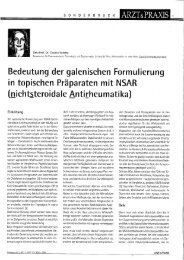Diclofenac Sodium 4% Spray Gel - cyathus.cz
Diclofenac Sodium 4% Spray Gel - cyathus.cz
Diclofenac Sodium 4% Spray Gel - cyathus.cz
Create successful ePaper yourself
Turn your PDF publications into a flip-book with our unique Google optimized e-Paper software.
PAR <strong>Diclofenac</strong> <strong>Sodium</strong> <strong>4%</strong> <strong>Spray</strong> <strong>Gel</strong><br />
UK/H/0562-3/001/E01<br />
As with other NSAIDs, diclofenac has been found to be an effective analgesic across<br />
the range of musculo-skeletal pathologies.<br />
This particular product contains the mono-sodium salt of the drug substance.<br />
Pharmacokinetics<br />
In the applicant’s clinical expert report, it is stated that this preparation (similar to the<br />
reference product Voltarol Emulgel) utilises ‘diadermal application’. This is explained<br />
as implying a predominately local effect of the active rather than one through<br />
systemic absorption (‘transdermal’ application). Whilst there were some earlier<br />
investigative data on the reference product gel formulation to the contrary, the<br />
applicant has performed a further study with this test product, which provides<br />
evidence that permeation of diclofenac to the ‘local’ target tissue appears significantly<br />
greater than systemic circulation.<br />
Quantitatively for topical applications of diclofenac (5g of 1% gel administered twice<br />
daily), it is estimated that the maximum plasma level is about 10%, and total AUC<br />
amounts correspond to 25 to 50% of the values seen after parenteral administration.<br />
<strong>Diclofenac</strong> is well absorbed after oral administration and undergoes first-pass<br />
metabolism in the liver, only 60% of the absorbed dose reaching the general<br />
circulation. In the plasma, the drug is extensively protein bound (>99%).<br />
Elimination is by hepatic metabolism followed by urinary and biliary excretion. The<br />
principal metabolite has negligible activity. The terminal half-life of elimination is<br />
about 1.8 hours.<br />
Pharmacokinetic studies<br />
Two studies are included in this application<br />
Study Summary [A]. An open, randomised, two-way cross-over study in 12 female<br />
subjects was performed in 1996.<br />
It was carried out in accordance with current EC GCP/GLP guidelines, under the<br />
Declaration of Helsinki and was approved by the local Ethics Committee.<br />
The study is described in the clinical expert report (pages 10-11), in the tabulated<br />
summaries (pages 55-7) and fully in Module 5, volumes 5-6 of the supporting<br />
documents.<br />
The study was designed to compare the pharmacokinetic parameters of test and<br />
reference (Voltarol Emulgel) products after single (in all subjects) and multiple doses<br />
(in a subset of 4 subjects) were administered topically. The stated aim was "to prove<br />
the safety of the test preparation" or to show that systemic plasma levels are of the<br />
same ‘pharmacologically irrelevant’ order.<br />
The subjects were all female between 19 and 41 years old, but one was withdrawn<br />
before the second phase (pregnant – data not used for pharmacokinetics) and replaced<br />
for the second half of the study.<br />
26



